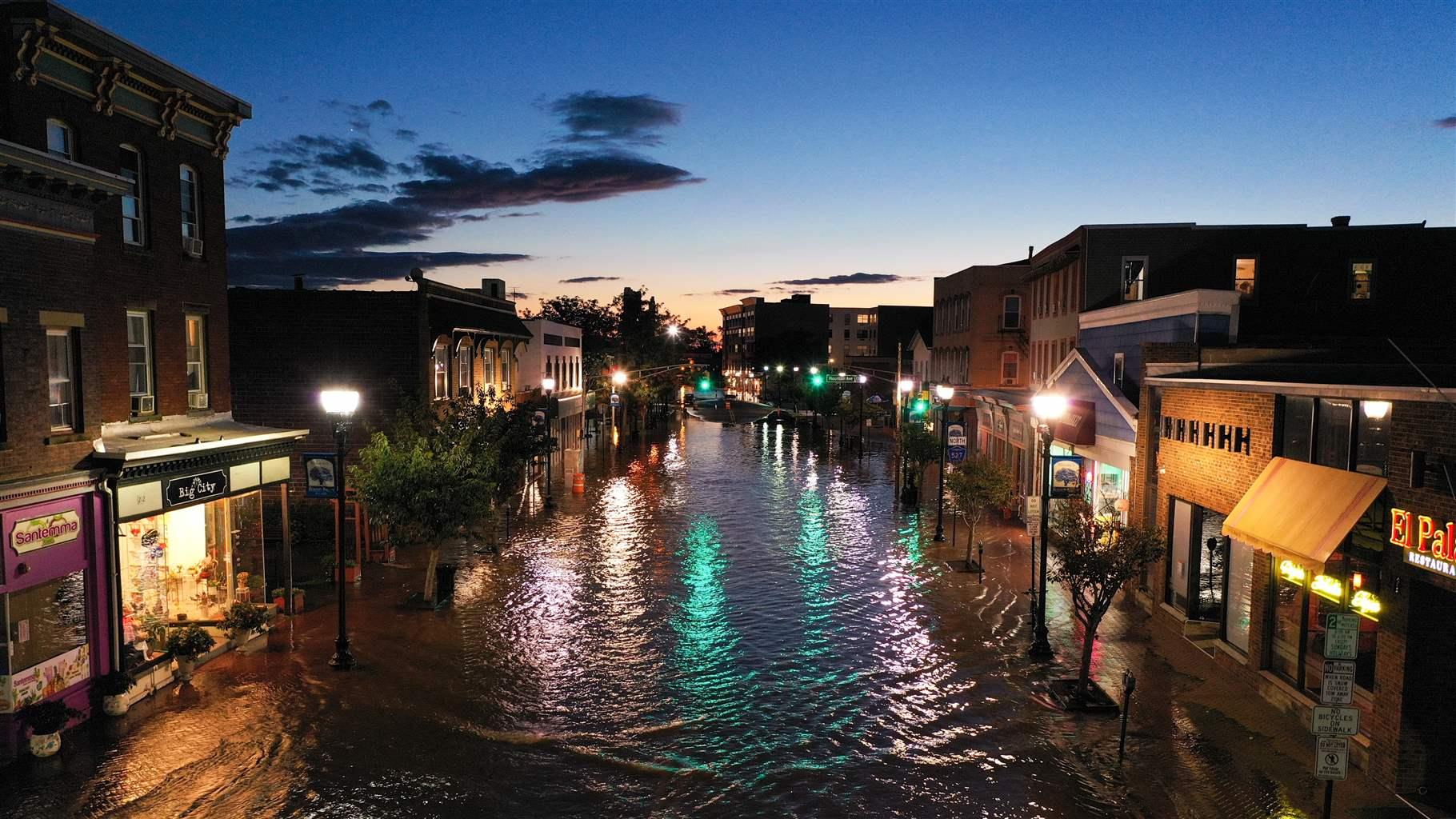State, Federal Collaboration Key to Improving Flood Policies as U.S. Faces a Wetter Future
Leaders point to gaps in public engagement and targeted assistance as barriers to progress

States seeking to improve their planning for flooding and other natural disasters should see the federal government as an ally and a valuable resource for data and guidance, including on how to access federal funding, said Brenda Mallory, chair of the White House Council on Environmental Quality. She made the remarks at a March 8 webinar on how all levels of government can better plan for climate impacts, an event hosted by the State Resilience Partnership, which was convened by The Pew Charitable Trusts. The conversation included the importance of factoring in future risks and protecting America’s most vulnerable communities, which tend to bear a disproportionate impact from climate change-driven disasters.
Mallory noted that the recently enacted Infrastructure Investment and Jobs Act “includes $50 billion for climate resiliency programs,” and that the White House has released a guidebook “to help state, local, tribal, and territorial governments unlock [these] historic investments.” Pew believes that the federal government, which has broad ambitions to improve the country’s resilience to climate change, must also concurrently boost its efforts to collaborate with states in order to achieve those goals.
Flooding is the most common and costly disaster in the United States, affecting every state and territory and contributing to more than $1 trillion in damage and losses since 2000. Experts believe these costs will grow as climate change continues to fuel sea-level rise and heavier, more frequent downpours across the country. Last year, 21 states experienced a flood-related presidentially declared disaster, and the United Nations Intergovernmental Panel on Climate Change recently issued its latest dire warning on increases in severe weather, threats to biodiversity, and more.
But many states lack the plans they need to accurately anticipate floods and minimize the threat they pose. At the webinar, the State Resilience Partnership unveiled a new report, prepared by the Urban Institute, that found many states’ flood planning relies on historic rather than forward-looking data.
In fact, many states had no flood-specific planning and some address that risk only in their federally required hazard mitigation plans, where flooding “is only a small component,” said Eric Burnstein, research associate at the Urban Institute. Of the 148 state resilience plans analyzed for the report, only 46% included future climate projections, despite a federal requirement to do so, Burnstein told the audience. Further, 84% of plans did not consider—or did so only minimally—the disproportionate impacts that flooding has on socially vulnerable communities. “The problem is systemic, and the solution must be systemic as well,” Burnstein told the more than 500 attendees.
During an ensuing panel discussion, one former and two current chief resilience officers shared their challenges—and successes—in advancing forward-looking flood policies. David Rosenblatt, who recently retired as New Jersey’s chief resilience officer, said his state has “a very good scientific basis on sea-level rises, on increased precipitation, [and] impacts on our river flood elevations, so for us science was not the problem.” But a big challenge policymakers faced, he said, “was getting the public to care about and trust the science. When we present the science to the public … they’re perceiving personal and economic hardships.”
To help overcome that, New Jersey has invited significant public participation in the formation of state policy. Residents “must be part of the process,” Rosenblatt said.
Amanda Martin, North Carolina’s chief resilience officer, agreed, and said her office had seen some success working with community representatives, especially in under-resourced neighborhoods.
“We have 10 million people in our state, and we can’t just blanket the state in outreach requests and meetings—it’s not cost-effective, and you only get the loudest voices” in response, Martin said. She advised other state resilience leaders to identify and work through people “whose job it is to represent under-represented groups.”
Martin said North Carolina is also working to alleviate the discrimination inherent in some policies and the policymaking process.
“Yes, some of this is driven by historic discrimination in the housing market … but other kinds of equity issues come from the structure of our policies, the fact that we are better able to invest in [residential] elevations or weather-proofing homes that are homeowner-occupied,” she said. “That leaves renters out. Or [that] the grant programs we have benefit those communities that have [local government] staff that are able to take time out of their day to write a great grant application.”
On a similar theme, Benjamin Duncan, chief resilience officer for South Carolina, said a big focus of his is serving people in low- to moderate-income communities that normally don’t get served. The pandemic made that harder, preventing the in-person interaction needed to bring neighborhoods on board with government initiatives. “But we’re reaching out, trying to engage the low- to moderate-[income] communities as part of our target audience so that they won’t get left out,” Duncan said. He noted that flooding quickly gained prominence as a statewide issue after South Carolina was hit with three hurricanes from 2015 to 2018. He also credited a constellation of partners, including research universities, the South Carolina Department of Climatology, Pew, and others, with providing valuable input for the state’s resilience plan, which his office is working to finalize.
Mallory agreed that mitigating flood risk for socially vulnerable communities is essential, and pointed to the Biden administration’s Justice40 Initiative, which promises to deliver at least 40% of the overall benefits from federal investments in climate and clean energy to disadvantaged communities.
In addition, Mallory added that she, like Pew, strongly supports nature-based solutions—such as wetland restoration, rain gardens, green roofs, and more—to mitigate flooding and that the infrastructure law provides “unprecedented opportunity” to implement those solutions, along with a requirement that all federally funded projects be climate resilient.
Floods and other natural disasters “are just going to continue to increase” due to climate change, she said. “Proactive planning [must] be a part of the way we are thinking about the federal expenditure of funds.”
Mathew Sanders manages state planning for The Pew Charitable Trusts’ flood-prepared communities project.












